Economic and Financial Analysis of British Red Cross Failure: Report
VerifiedAdded on 2023/01/06
|9
|2136
|94
Report
AI Summary
This report presents an analysis of the British Red Cross, a non-profit organization, focusing on the factors contributing to its failure. It begins with an executive summary and an introduction to the organization's mission. The core of the report involves an environmental analysis using PESTLE and SWOT frameworks to assess the political, economic, social, technological, environmental, and legal factors affecting the charity. The SWOT analysis details the organization's strengths, weaknesses, opportunities, and threats. The report also delves into financial management practices specific to non-profit organizations, contrasting them with for-profit models. Finally, it provides recommendations and conclusions based on the analysis, referencing various academic sources. The report highlights the impact of micro and macro economic factors on the organization, emphasizing the challenges faced by the British Red Cross within its operational environment. The analysis focuses on the financial sustainability and management practices of the organization.

Economic and Financial
Management
Management
Paraphrase This Document
Need a fresh take? Get an instant paraphrase of this document with our AI Paraphraser
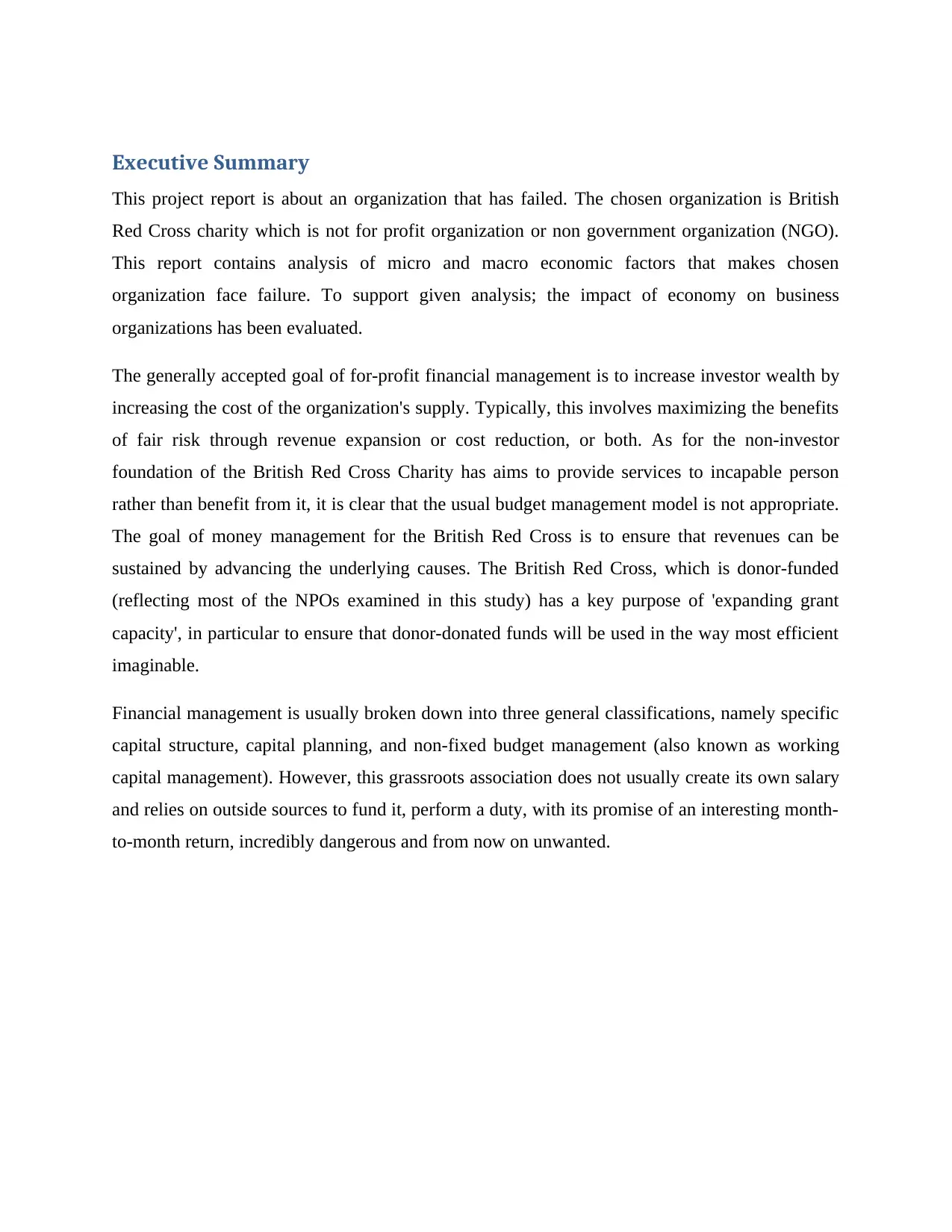
Executive Summary
This project report is about an organization that has failed. The chosen organization is British
Red Cross charity which is not for profit organization or non government organization (NGO).
This report contains analysis of micro and macro economic factors that makes chosen
organization face failure. To support given analysis; the impact of economy on business
organizations has been evaluated.
The generally accepted goal of for-profit financial management is to increase investor wealth by
increasing the cost of the organization's supply. Typically, this involves maximizing the benefits
of fair risk through revenue expansion or cost reduction, or both. As for the non-investor
foundation of the British Red Cross Charity has aims to provide services to incapable person
rather than benefit from it, it is clear that the usual budget management model is not appropriate.
The goal of money management for the British Red Cross is to ensure that revenues can be
sustained by advancing the underlying causes. The British Red Cross, which is donor-funded
(reflecting most of the NPOs examined in this study) has a key purpose of 'expanding grant
capacity', in particular to ensure that donor-donated funds will be used in the way most efficient
imaginable.
Financial management is usually broken down into three general classifications, namely specific
capital structure, capital planning, and non-fixed budget management (also known as working
capital management). However, this grassroots association does not usually create its own salary
and relies on outside sources to fund it, perform a duty, with its promise of an interesting month-
to-month return, incredibly dangerous and from now on unwanted.
This project report is about an organization that has failed. The chosen organization is British
Red Cross charity which is not for profit organization or non government organization (NGO).
This report contains analysis of micro and macro economic factors that makes chosen
organization face failure. To support given analysis; the impact of economy on business
organizations has been evaluated.
The generally accepted goal of for-profit financial management is to increase investor wealth by
increasing the cost of the organization's supply. Typically, this involves maximizing the benefits
of fair risk through revenue expansion or cost reduction, or both. As for the non-investor
foundation of the British Red Cross Charity has aims to provide services to incapable person
rather than benefit from it, it is clear that the usual budget management model is not appropriate.
The goal of money management for the British Red Cross is to ensure that revenues can be
sustained by advancing the underlying causes. The British Red Cross, which is donor-funded
(reflecting most of the NPOs examined in this study) has a key purpose of 'expanding grant
capacity', in particular to ensure that donor-donated funds will be used in the way most efficient
imaginable.
Financial management is usually broken down into three general classifications, namely specific
capital structure, capital planning, and non-fixed budget management (also known as working
capital management). However, this grassroots association does not usually create its own salary
and relies on outside sources to fund it, perform a duty, with its promise of an interesting month-
to-month return, incredibly dangerous and from now on unwanted.
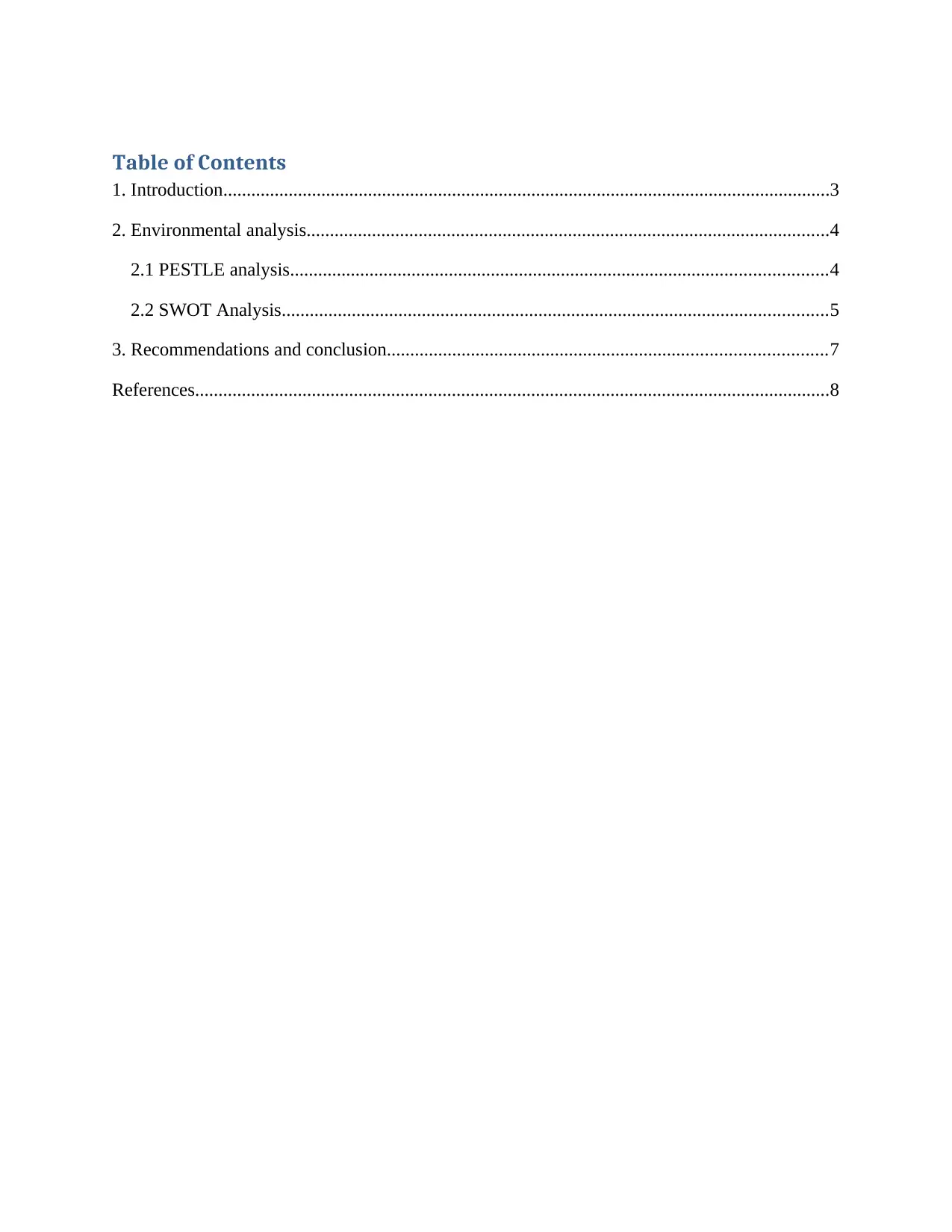
Table of Contents
1. Introduction..................................................................................................................................3
2. Environmental analysis................................................................................................................4
2.1 PESTLE analysis...................................................................................................................4
2.2 SWOT Analysis.....................................................................................................................5
3. Recommendations and conclusion..............................................................................................7
References........................................................................................................................................8
1. Introduction..................................................................................................................................3
2. Environmental analysis................................................................................................................4
2.1 PESTLE analysis...................................................................................................................4
2.2 SWOT Analysis.....................................................................................................................5
3. Recommendations and conclusion..............................................................................................7
References........................................................................................................................................8
⊘ This is a preview!⊘
Do you want full access?
Subscribe today to unlock all pages.

Trusted by 1+ million students worldwide
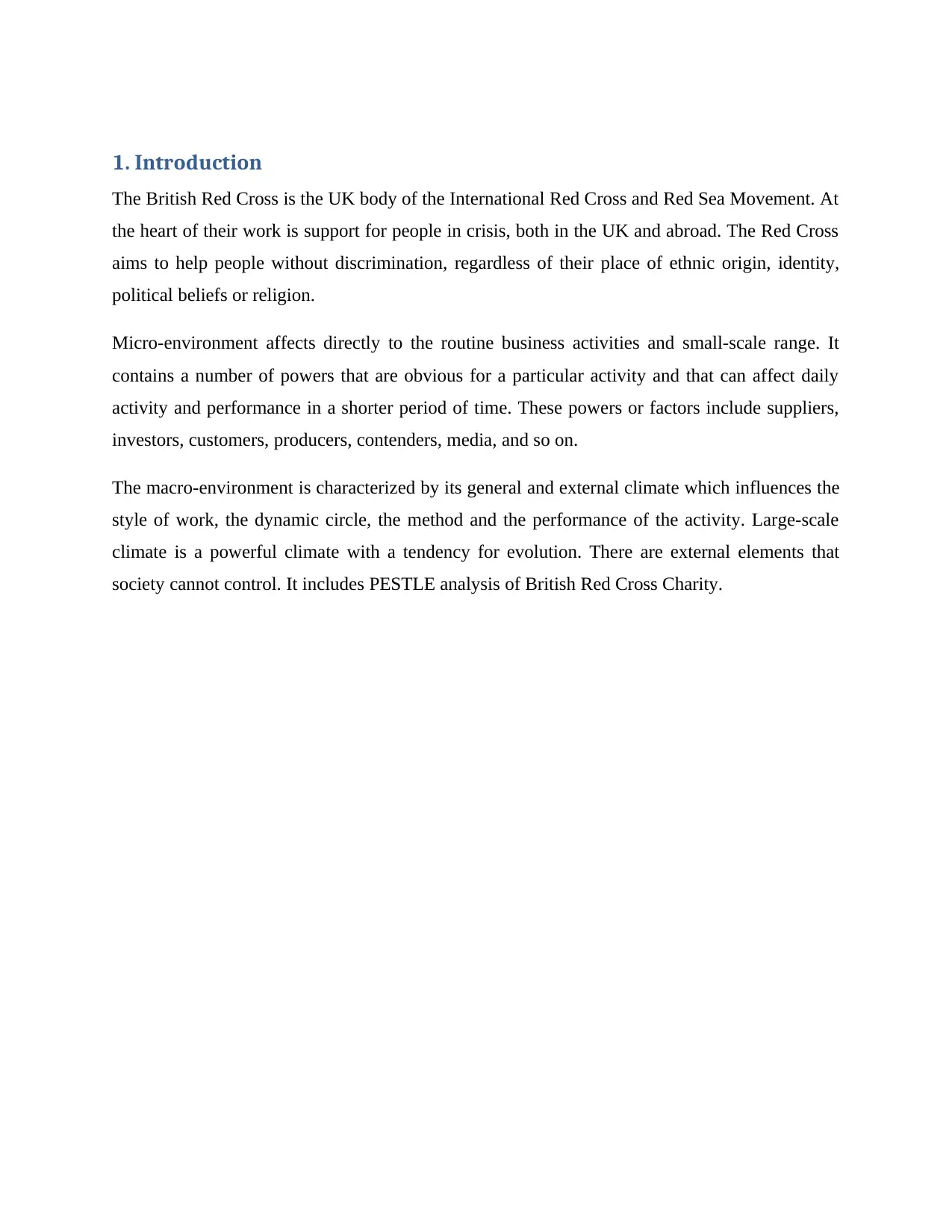
1. Introduction
The British Red Cross is the UK body of the International Red Cross and Red Sea Movement. At
the heart of their work is support for people in crisis, both in the UK and abroad. The Red Cross
aims to help people without discrimination, regardless of their place of ethnic origin, identity,
political beliefs or religion.
Micro-environment affects directly to the routine business activities and small-scale range. It
contains a number of powers that are obvious for a particular activity and that can affect daily
activity and performance in a shorter period of time. These powers or factors include suppliers,
investors, customers, producers, contenders, media, and so on.
The macro-environment is characterized by its general and external climate which influences the
style of work, the dynamic circle, the method and the performance of the activity. Large-scale
climate is a powerful climate with a tendency for evolution. There are external elements that
society cannot control. It includes PESTLE analysis of British Red Cross Charity.
The British Red Cross is the UK body of the International Red Cross and Red Sea Movement. At
the heart of their work is support for people in crisis, both in the UK and abroad. The Red Cross
aims to help people without discrimination, regardless of their place of ethnic origin, identity,
political beliefs or religion.
Micro-environment affects directly to the routine business activities and small-scale range. It
contains a number of powers that are obvious for a particular activity and that can affect daily
activity and performance in a shorter period of time. These powers or factors include suppliers,
investors, customers, producers, contenders, media, and so on.
The macro-environment is characterized by its general and external climate which influences the
style of work, the dynamic circle, the method and the performance of the activity. Large-scale
climate is a powerful climate with a tendency for evolution. There are external elements that
society cannot control. It includes PESTLE analysis of British Red Cross Charity.
Paraphrase This Document
Need a fresh take? Get an instant paraphrase of this document with our AI Paraphraser
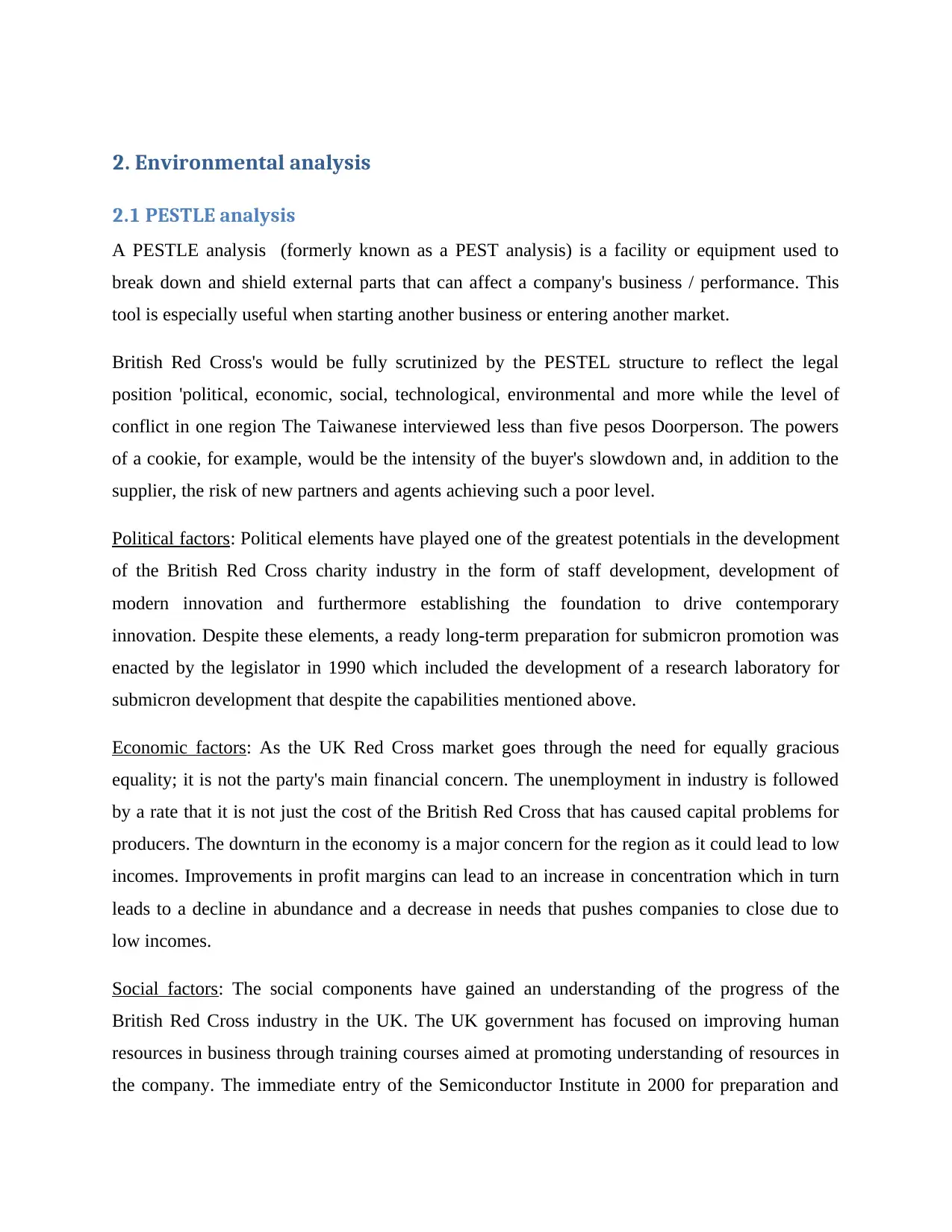
2. Environmental analysis
2.1 PESTLE analysis
A PESTLE analysis (formerly known as a PEST analysis) is a facility or equipment used to
break down and shield external parts that can affect a company's business / performance. This
tool is especially useful when starting another business or entering another market.
British Red Cross's would be fully scrutinized by the PESTEL structure to reflect the legal
position 'political, economic, social, technological, environmental and more while the level of
conflict in one region The Taiwanese interviewed less than five pesos Doorperson. The powers
of a cookie, for example, would be the intensity of the buyer's slowdown and, in addition to the
supplier, the risk of new partners and agents achieving such a poor level.
Political factors: Political elements have played one of the greatest potentials in the development
of the British Red Cross charity industry in the form of staff development, development of
modern innovation and furthermore establishing the foundation to drive contemporary
innovation. Despite these elements, a ready long-term preparation for submicron promotion was
enacted by the legislator in 1990 which included the development of a research laboratory for
submicron development that despite the capabilities mentioned above.
Economic factors: As the UK Red Cross market goes through the need for equally gracious
equality; it is not the party's main financial concern. The unemployment in industry is followed
by a rate that it is not just the cost of the British Red Cross that has caused capital problems for
producers. The downturn in the economy is a major concern for the region as it could lead to low
incomes. Improvements in profit margins can lead to an increase in concentration which in turn
leads to a decline in abundance and a decrease in needs that pushes companies to close due to
low incomes.
Social factors: The social components have gained an understanding of the progress of the
British Red Cross industry in the UK. The UK government has focused on improving human
resources in business through training courses aimed at promoting understanding of resources in
the company. The immediate entry of the Semiconductor Institute in 2000 for preparation and
2.1 PESTLE analysis
A PESTLE analysis (formerly known as a PEST analysis) is a facility or equipment used to
break down and shield external parts that can affect a company's business / performance. This
tool is especially useful when starting another business or entering another market.
British Red Cross's would be fully scrutinized by the PESTEL structure to reflect the legal
position 'political, economic, social, technological, environmental and more while the level of
conflict in one region The Taiwanese interviewed less than five pesos Doorperson. The powers
of a cookie, for example, would be the intensity of the buyer's slowdown and, in addition to the
supplier, the risk of new partners and agents achieving such a poor level.
Political factors: Political elements have played one of the greatest potentials in the development
of the British Red Cross charity industry in the form of staff development, development of
modern innovation and furthermore establishing the foundation to drive contemporary
innovation. Despite these elements, a ready long-term preparation for submicron promotion was
enacted by the legislator in 1990 which included the development of a research laboratory for
submicron development that despite the capabilities mentioned above.
Economic factors: As the UK Red Cross market goes through the need for equally gracious
equality; it is not the party's main financial concern. The unemployment in industry is followed
by a rate that it is not just the cost of the British Red Cross that has caused capital problems for
producers. The downturn in the economy is a major concern for the region as it could lead to low
incomes. Improvements in profit margins can lead to an increase in concentration which in turn
leads to a decline in abundance and a decrease in needs that pushes companies to close due to
low incomes.
Social factors: The social components have gained an understanding of the progress of the
British Red Cross industry in the UK. The UK government has focused on improving human
resources in business through training courses aimed at promoting understanding of resources in
the company. The immediate entry of the Semiconductor Institute in 2000 for preparation and
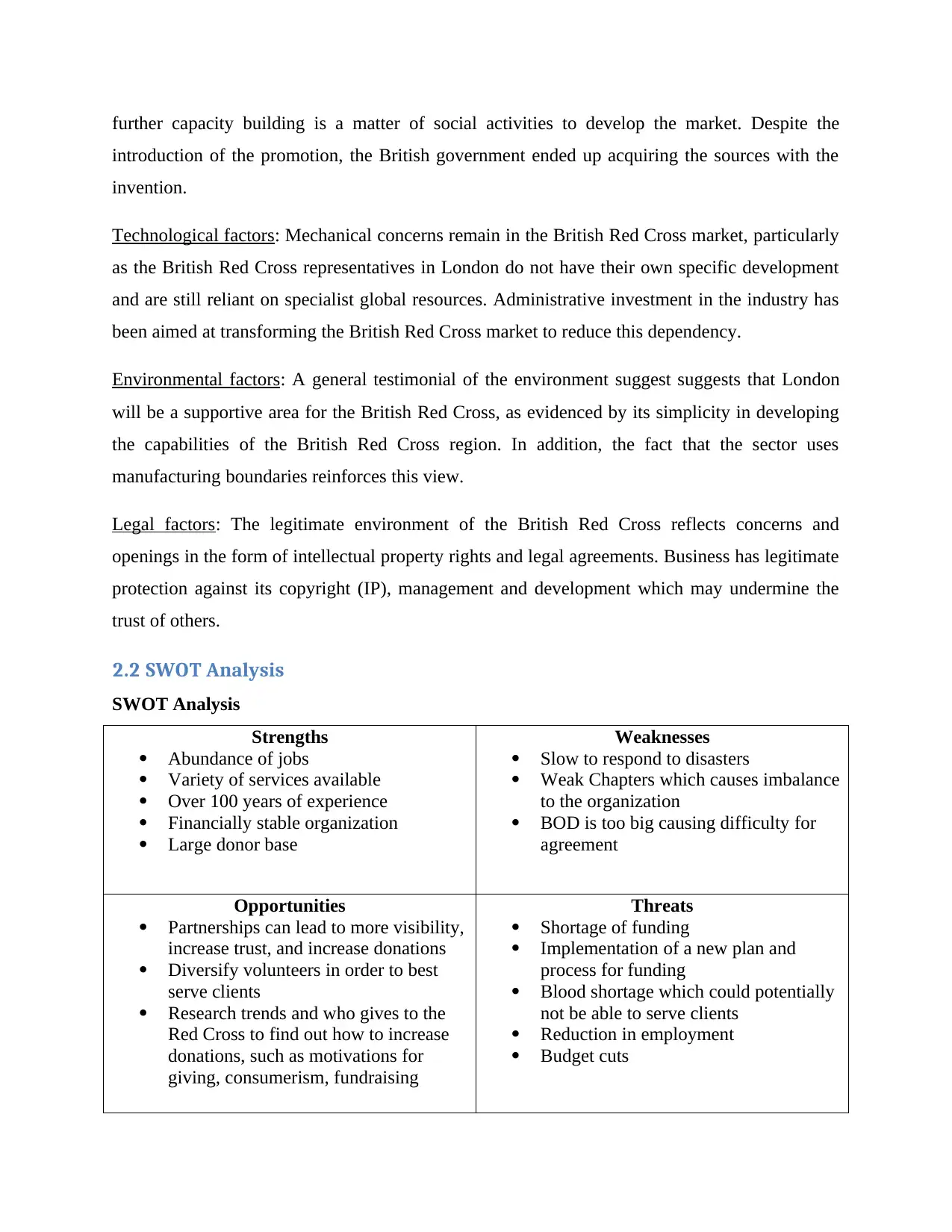
further capacity building is a matter of social activities to develop the market. Despite the
introduction of the promotion, the British government ended up acquiring the sources with the
invention.
Technological factors: Mechanical concerns remain in the British Red Cross market, particularly
as the British Red Cross representatives in London do not have their own specific development
and are still reliant on specialist global resources. Administrative investment in the industry has
been aimed at transforming the British Red Cross market to reduce this dependency.
Environmental factors: A general testimonial of the environment suggest suggests that London
will be a supportive area for the British Red Cross, as evidenced by its simplicity in developing
the capabilities of the British Red Cross region. In addition, the fact that the sector uses
manufacturing boundaries reinforces this view.
Legal factors: The legitimate environment of the British Red Cross reflects concerns and
openings in the form of intellectual property rights and legal agreements. Business has legitimate
protection against its copyright (IP), management and development which may undermine the
trust of others.
2.2 SWOT Analysis
SWOT Analysis
Strengths
Abundance of jobs
Variety of services available
Over 100 years of experience
Financially stable organization
Large donor base
Weaknesses
Slow to respond to disasters
Weak Chapters which causes imbalance
to the organization
BOD is too big causing difficulty for
agreement
Opportunities
Partnerships can lead to more visibility,
increase trust, and increase donations
Diversify volunteers in order to best
serve clients
Research trends and who gives to the
Red Cross to find out how to increase
donations, such as motivations for
giving, consumerism, fundraising
Threats
Shortage of funding
Implementation of a new plan and
process for funding
Blood shortage which could potentially
not be able to serve clients
Reduction in employment
Budget cuts
introduction of the promotion, the British government ended up acquiring the sources with the
invention.
Technological factors: Mechanical concerns remain in the British Red Cross market, particularly
as the British Red Cross representatives in London do not have their own specific development
and are still reliant on specialist global resources. Administrative investment in the industry has
been aimed at transforming the British Red Cross market to reduce this dependency.
Environmental factors: A general testimonial of the environment suggest suggests that London
will be a supportive area for the British Red Cross, as evidenced by its simplicity in developing
the capabilities of the British Red Cross region. In addition, the fact that the sector uses
manufacturing boundaries reinforces this view.
Legal factors: The legitimate environment of the British Red Cross reflects concerns and
openings in the form of intellectual property rights and legal agreements. Business has legitimate
protection against its copyright (IP), management and development which may undermine the
trust of others.
2.2 SWOT Analysis
SWOT Analysis
Strengths
Abundance of jobs
Variety of services available
Over 100 years of experience
Financially stable organization
Large donor base
Weaknesses
Slow to respond to disasters
Weak Chapters which causes imbalance
to the organization
BOD is too big causing difficulty for
agreement
Opportunities
Partnerships can lead to more visibility,
increase trust, and increase donations
Diversify volunteers in order to best
serve clients
Research trends and who gives to the
Red Cross to find out how to increase
donations, such as motivations for
giving, consumerism, fundraising
Threats
Shortage of funding
Implementation of a new plan and
process for funding
Blood shortage which could potentially
not be able to serve clients
Reduction in employment
Budget cuts
⊘ This is a preview!⊘
Do you want full access?
Subscribe today to unlock all pages.

Trusted by 1+ million students worldwide
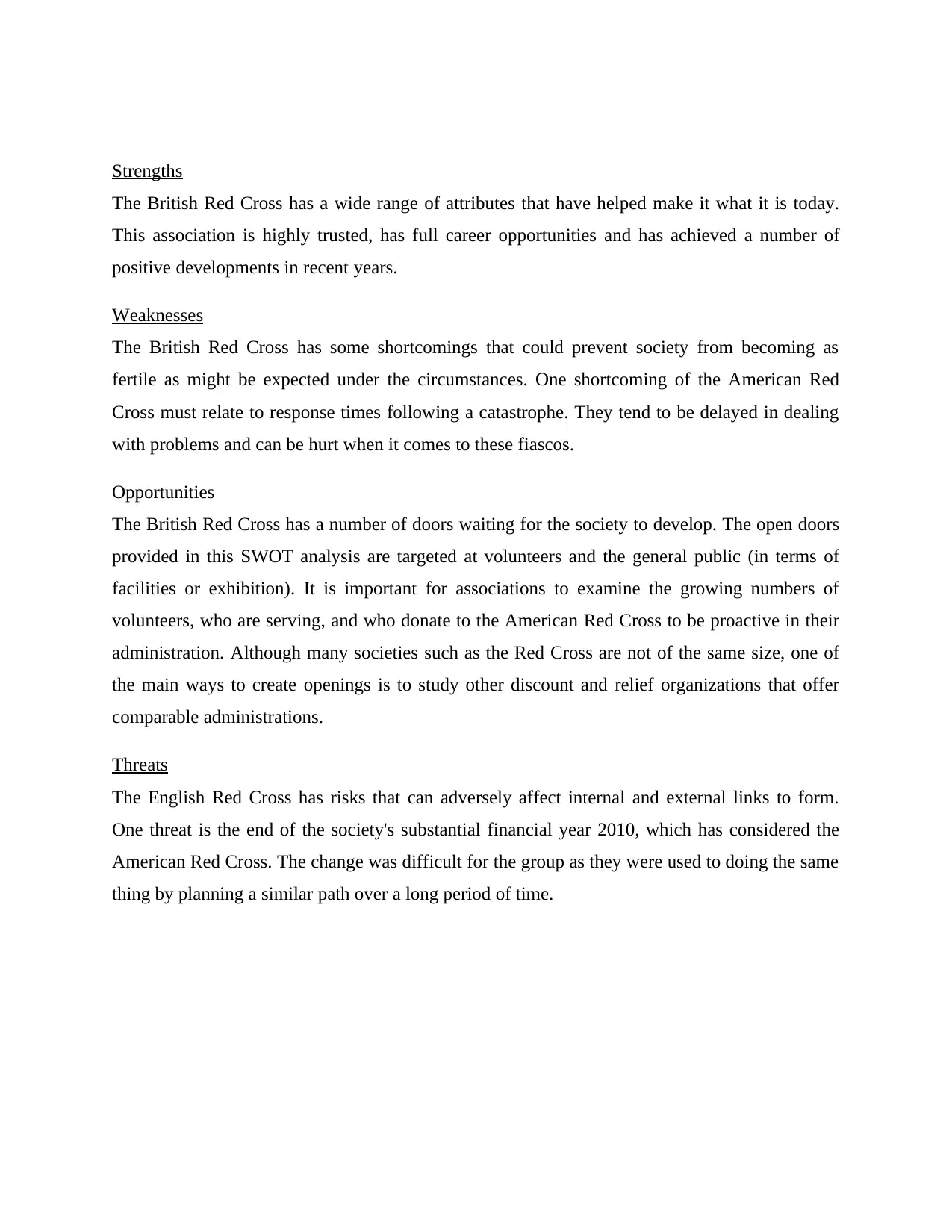
Strengths
The British Red Cross has a wide range of attributes that have helped make it what it is today.
This association is highly trusted, has full career opportunities and has achieved a number of
positive developments in recent years.
Weaknesses
The British Red Cross has some shortcomings that could prevent society from becoming as
fertile as might be expected under the circumstances. One shortcoming of the American Red
Cross must relate to response times following a catastrophe. They tend to be delayed in dealing
with problems and can be hurt when it comes to these fiascos.
Opportunities
The British Red Cross has a number of doors waiting for the society to develop. The open doors
provided in this SWOT analysis are targeted at volunteers and the general public (in terms of
facilities or exhibition). It is important for associations to examine the growing numbers of
volunteers, who are serving, and who donate to the American Red Cross to be proactive in their
administration. Although many societies such as the Red Cross are not of the same size, one of
the main ways to create openings is to study other discount and relief organizations that offer
comparable administrations.
Threats
The English Red Cross has risks that can adversely affect internal and external links to form.
One threat is the end of the society's substantial financial year 2010, which has considered the
American Red Cross. The change was difficult for the group as they were used to doing the same
thing by planning a similar path over a long period of time.
The British Red Cross has a wide range of attributes that have helped make it what it is today.
This association is highly trusted, has full career opportunities and has achieved a number of
positive developments in recent years.
Weaknesses
The British Red Cross has some shortcomings that could prevent society from becoming as
fertile as might be expected under the circumstances. One shortcoming of the American Red
Cross must relate to response times following a catastrophe. They tend to be delayed in dealing
with problems and can be hurt when it comes to these fiascos.
Opportunities
The British Red Cross has a number of doors waiting for the society to develop. The open doors
provided in this SWOT analysis are targeted at volunteers and the general public (in terms of
facilities or exhibition). It is important for associations to examine the growing numbers of
volunteers, who are serving, and who donate to the American Red Cross to be proactive in their
administration. Although many societies such as the Red Cross are not of the same size, one of
the main ways to create openings is to study other discount and relief organizations that offer
comparable administrations.
Threats
The English Red Cross has risks that can adversely affect internal and external links to form.
One threat is the end of the society's substantial financial year 2010, which has considered the
American Red Cross. The change was difficult for the group as they were used to doing the same
thing by planning a similar path over a long period of time.
Paraphrase This Document
Need a fresh take? Get an instant paraphrase of this document with our AI Paraphraser
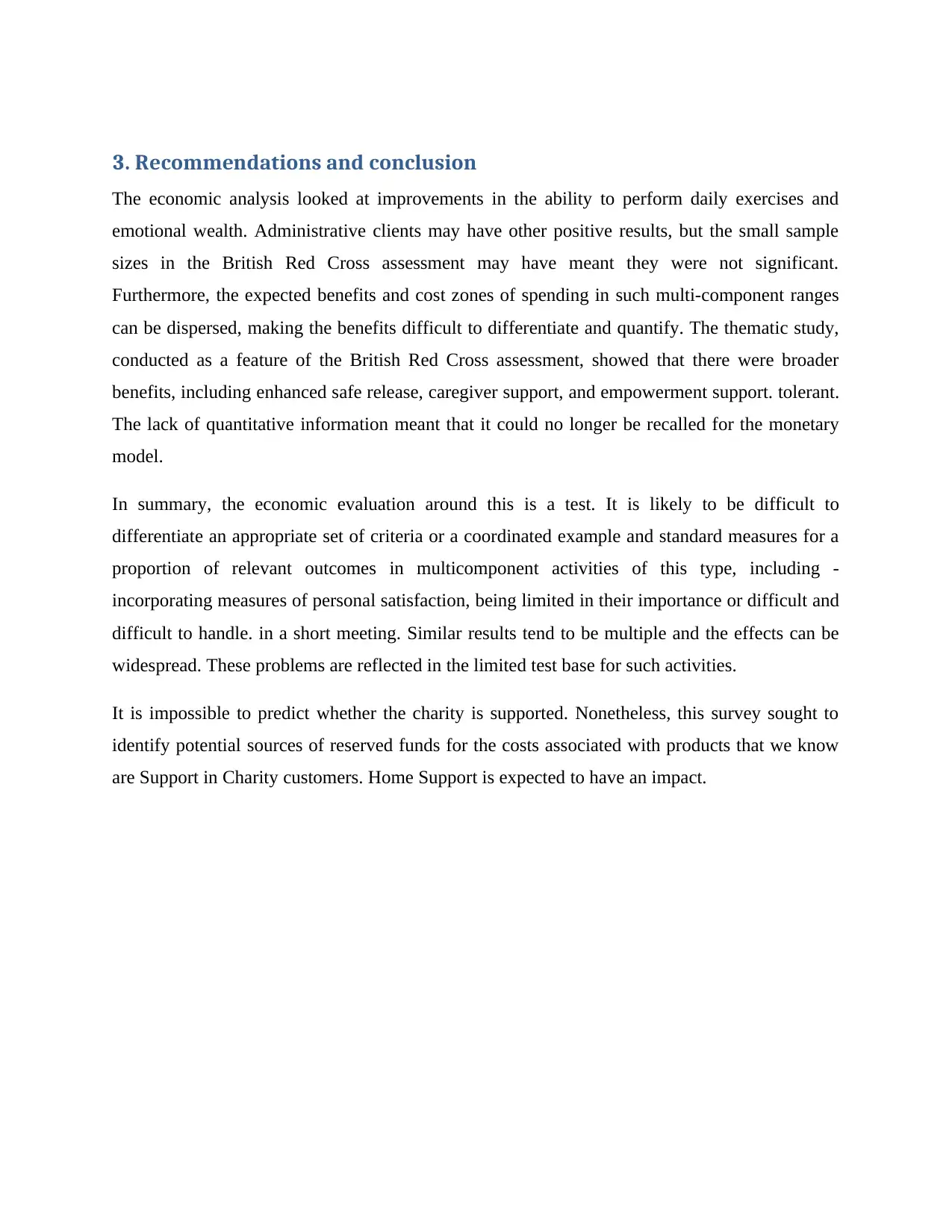
3. Recommendations and conclusion
The economic analysis looked at improvements in the ability to perform daily exercises and
emotional wealth. Administrative clients may have other positive results, but the small sample
sizes in the British Red Cross assessment may have meant they were not significant.
Furthermore, the expected benefits and cost zones of spending in such multi-component ranges
can be dispersed, making the benefits difficult to differentiate and quantify. The thematic study,
conducted as a feature of the British Red Cross assessment, showed that there were broader
benefits, including enhanced safe release, caregiver support, and empowerment support. tolerant.
The lack of quantitative information meant that it could no longer be recalled for the monetary
model.
In summary, the economic evaluation around this is a test. It is likely to be difficult to
differentiate an appropriate set of criteria or a coordinated example and standard measures for a
proportion of relevant outcomes in multicomponent activities of this type, including -
incorporating measures of personal satisfaction, being limited in their importance or difficult and
difficult to handle. in a short meeting. Similar results tend to be multiple and the effects can be
widespread. These problems are reflected in the limited test base for such activities.
It is impossible to predict whether the charity is supported. Nonetheless, this survey sought to
identify potential sources of reserved funds for the costs associated with products that we know
are Support in Charity customers. Home Support is expected to have an impact.
The economic analysis looked at improvements in the ability to perform daily exercises and
emotional wealth. Administrative clients may have other positive results, but the small sample
sizes in the British Red Cross assessment may have meant they were not significant.
Furthermore, the expected benefits and cost zones of spending in such multi-component ranges
can be dispersed, making the benefits difficult to differentiate and quantify. The thematic study,
conducted as a feature of the British Red Cross assessment, showed that there were broader
benefits, including enhanced safe release, caregiver support, and empowerment support. tolerant.
The lack of quantitative information meant that it could no longer be recalled for the monetary
model.
In summary, the economic evaluation around this is a test. It is likely to be difficult to
differentiate an appropriate set of criteria or a coordinated example and standard measures for a
proportion of relevant outcomes in multicomponent activities of this type, including -
incorporating measures of personal satisfaction, being limited in their importance or difficult and
difficult to handle. in a short meeting. Similar results tend to be multiple and the effects can be
widespread. These problems are reflected in the limited test base for such activities.
It is impossible to predict whether the charity is supported. Nonetheless, this survey sought to
identify potential sources of reserved funds for the costs associated with products that we know
are Support in Charity customers. Home Support is expected to have an impact.

References
Banks J., Lessof C., Nazroo J., Rogers N., Stafford M. and Steptoe A. (eds) (2010) Financial
circumstances, health and well-being of the older population in England: ELSA 2008
(Wave 4), Institute of Fiscal Studies.
Bauer A., Knapp M. and Perkins M. (2011) Befriending of older adults, in M. Knapp, M.
McDaid and M. Parsonage (eds), Mental Health Promotion and Mental Illness Prevention:
The economic case, London, Personal Social Services Research Unit and London School
of Economics and Political Science, and the Department of Health.
Bien B., McKee K.J., Döhner H., Triantafillou J., Lamura G., Doroszkiewicz H., Krevers B. and
Kofahl C. (2013) Disabled older people’s use of health and social care services and their
unmet care needs in six European countries, European Journal of Public Health, Advance
Access via Oxford University Press.
Bragstad L.K., Kirkevold M., Hofoss D. and Foss C. (2012) Factors predicting a successful
postdischarge outcome for individuals aged 80 years and over, International Journal of
Integrated Care, 12.
Brannelly T. and Matthews B. (2010) When practical help is valued so much by older people,
why do professionals fail to recognise its value?, Journal of Integrated Care. 18, 2, 33–40.
Curtis L. (2011) Unit Costs of Health and Social Care 2011. Canterbury: Personal Social
Services Research Unit, University of Kent.
Curtis L. (2012) Unit Costs of Health and Social Care 2012. Canterbury: Personal Social
Services Research Unit, University of Kent.
Graham C., Campion J., Kaiser P. and Edwards K. (2011) Management of depression in older
people; why is this important in primary care, Royal College of General
Practitioners/Royal College of Psychiatrists.
Banks J., Lessof C., Nazroo J., Rogers N., Stafford M. and Steptoe A. (eds) (2010) Financial
circumstances, health and well-being of the older population in England: ELSA 2008
(Wave 4), Institute of Fiscal Studies.
Bauer A., Knapp M. and Perkins M. (2011) Befriending of older adults, in M. Knapp, M.
McDaid and M. Parsonage (eds), Mental Health Promotion and Mental Illness Prevention:
The economic case, London, Personal Social Services Research Unit and London School
of Economics and Political Science, and the Department of Health.
Bien B., McKee K.J., Döhner H., Triantafillou J., Lamura G., Doroszkiewicz H., Krevers B. and
Kofahl C. (2013) Disabled older people’s use of health and social care services and their
unmet care needs in six European countries, European Journal of Public Health, Advance
Access via Oxford University Press.
Bragstad L.K., Kirkevold M., Hofoss D. and Foss C. (2012) Factors predicting a successful
postdischarge outcome for individuals aged 80 years and over, International Journal of
Integrated Care, 12.
Brannelly T. and Matthews B. (2010) When practical help is valued so much by older people,
why do professionals fail to recognise its value?, Journal of Integrated Care. 18, 2, 33–40.
Curtis L. (2011) Unit Costs of Health and Social Care 2011. Canterbury: Personal Social
Services Research Unit, University of Kent.
Curtis L. (2012) Unit Costs of Health and Social Care 2012. Canterbury: Personal Social
Services Research Unit, University of Kent.
Graham C., Campion J., Kaiser P. and Edwards K. (2011) Management of depression in older
people; why is this important in primary care, Royal College of General
Practitioners/Royal College of Psychiatrists.
⊘ This is a preview!⊘
Do you want full access?
Subscribe today to unlock all pages.

Trusted by 1+ million students worldwide
1 out of 9
Related Documents
Your All-in-One AI-Powered Toolkit for Academic Success.
+13062052269
info@desklib.com
Available 24*7 on WhatsApp / Email
![[object Object]](/_next/static/media/star-bottom.7253800d.svg)
Unlock your academic potential
Copyright © 2020–2025 A2Z Services. All Rights Reserved. Developed and managed by ZUCOL.





